Maddening months at work, trying to migrate a very large Web site to a different technology, and no end in sight. It's time to take a break and, as luck would have it, Kristin's coming for a visit. We'll go to France for a while.
You
may not find this terribly rewarding unless you're included here, so this is a
good time for casual and random browsers to turn back before they get too caught
up in the sweep and majesty of the proceedings and can't let go.
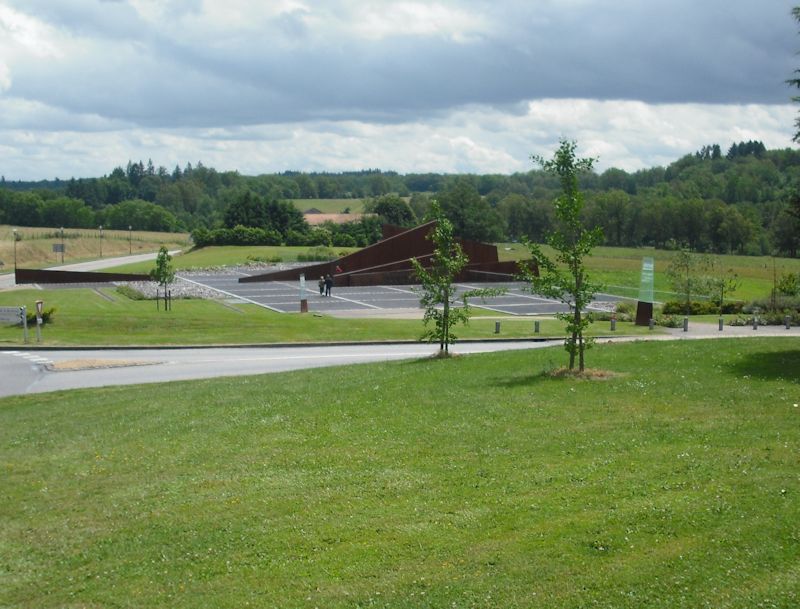
Some of us always look on the bright side and face the future with a fixed smile. Others take a more distressing view of human nature and let the past fester in the present. Kristin really wants to see Oradour and reflect upon it, and those of us who would have preferred to play ping-pong for the afternoon will have to follow along.
This is the visitors' centre -- actually this is the top of it, the complex of museum, gift shops, and visitor facilities is suitably buried underground.
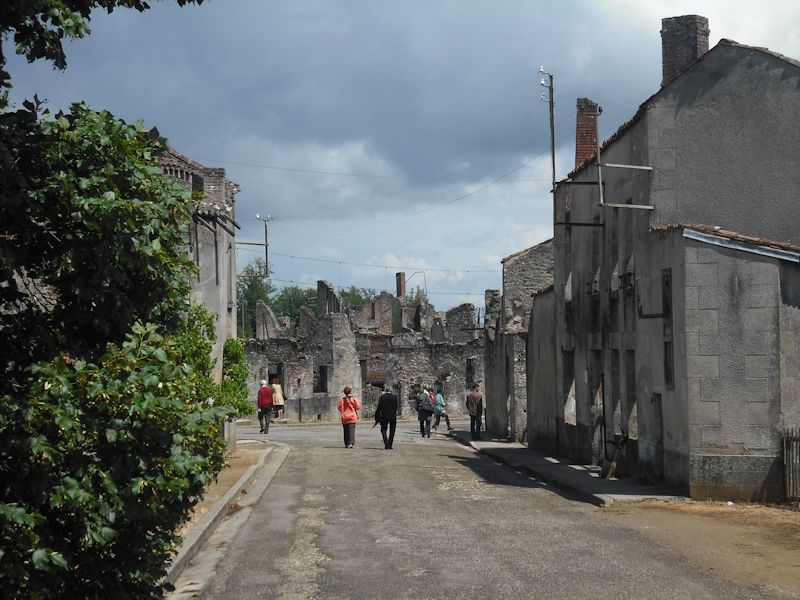
There we found an extremely sobering walk through an excellent museum, chronicling the rise of Nazism in Germany, the advent of the war, and the life of the citizens of Oradour as they hid out what refugees they could and otherwise got on with the daily struggle. This was not a good beginning to the day for a positive-thinking and chirpy fellow like myself.
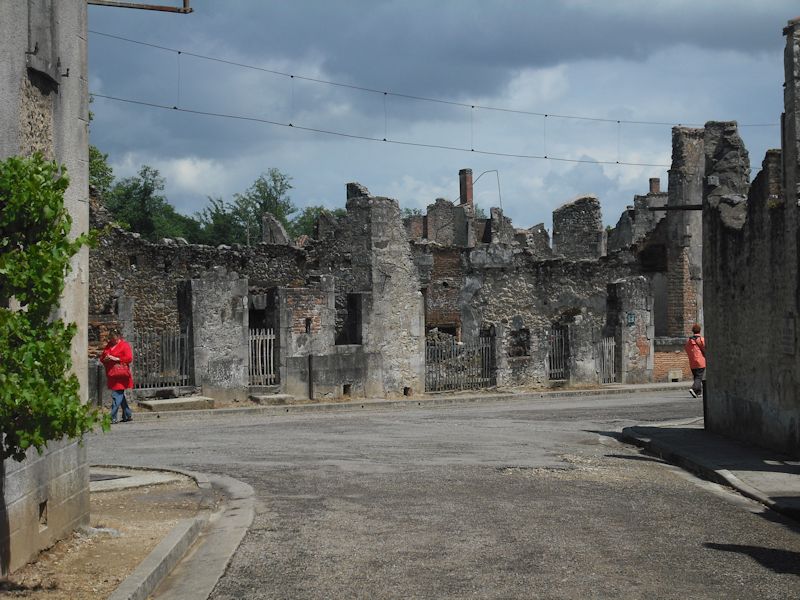
From the museum one strolls out into the remains of the village itself. The story of Oradour is pretty well known and I needn't belabor it. On 10 June 1944, the German authorities pulling the strings of the Vichy French regime apparently decided to make an example of a village suspected of aiding the maquis resistance, and for reasons still unknown, despite the documentary archives described in the museum, they chose Oradour-sur-Glane for their fireworks display. Some people think they mixed it up with another Oradour some ways off.
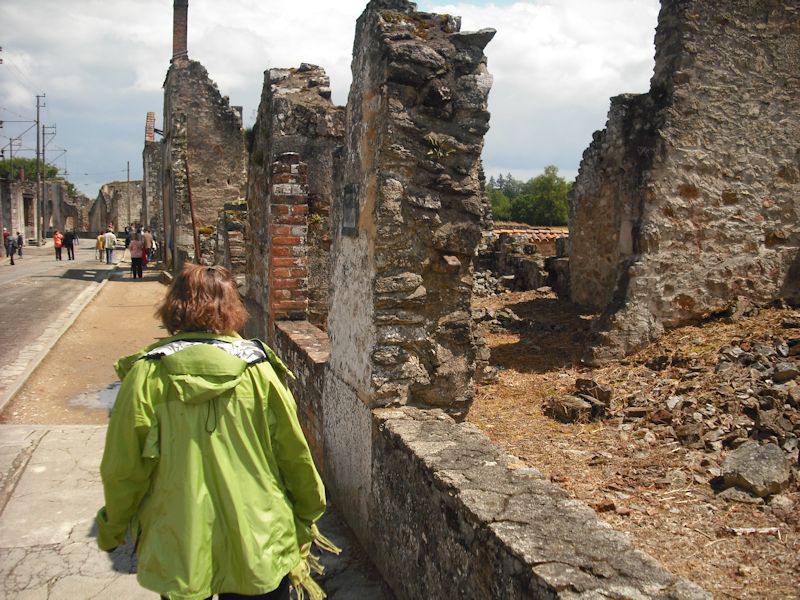
Just after noon, about 180 soldiers of the Der Führer Regiment of the 2nd Waffen-SS Panzer Division Das Reich rolled up, encircled the village, and dug in. Then they requested all the inhabitants to assemble in the village square for an identity-papers check.
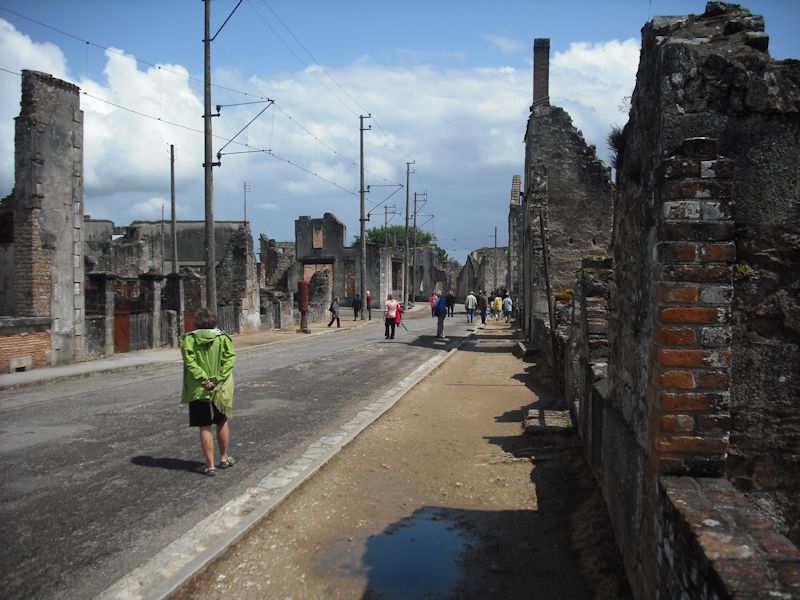
Evidently, this detachment of German soldiers had been brought up from Bordeaux and consisted mainly of brand-new and scarcely trained underage conscripts, who were actually en route to Normandy to try to repulse the D-Day Allied landings that had begun a few days earlier, where they got their own butts kicked. Many of them happened to be Alsatians, which means that their families had been intermittently French and German as the border flitted back and forth during the previous century.

After some hours of dithering, as no one seemed to know what was going on, the villagers discussed matters in the village square with some trepidation, and evidently the Germans discussed amongst themselves what they were supposed to be doing here. They were out of radio contact with HQ and couldn't get through on the mayor's telephone because they already had the only telephone operator rounded up in the village square.
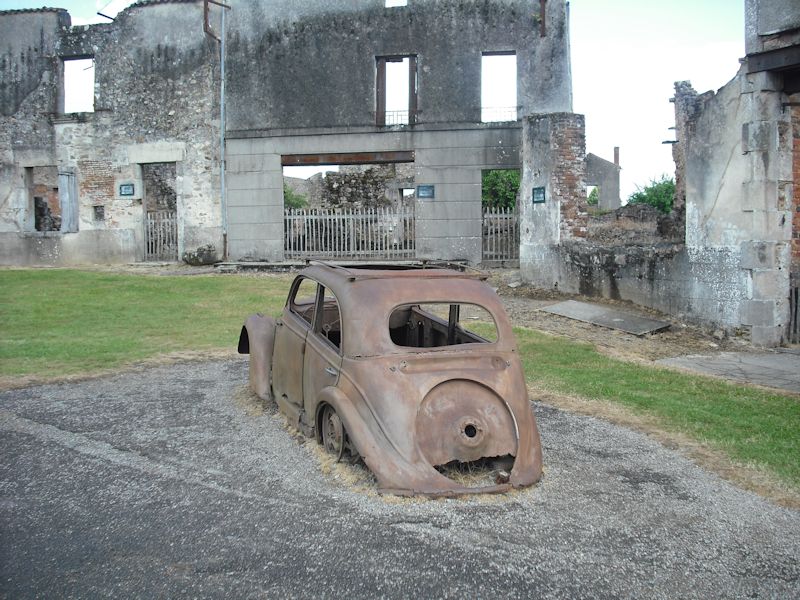
Dr Desourteaux's car
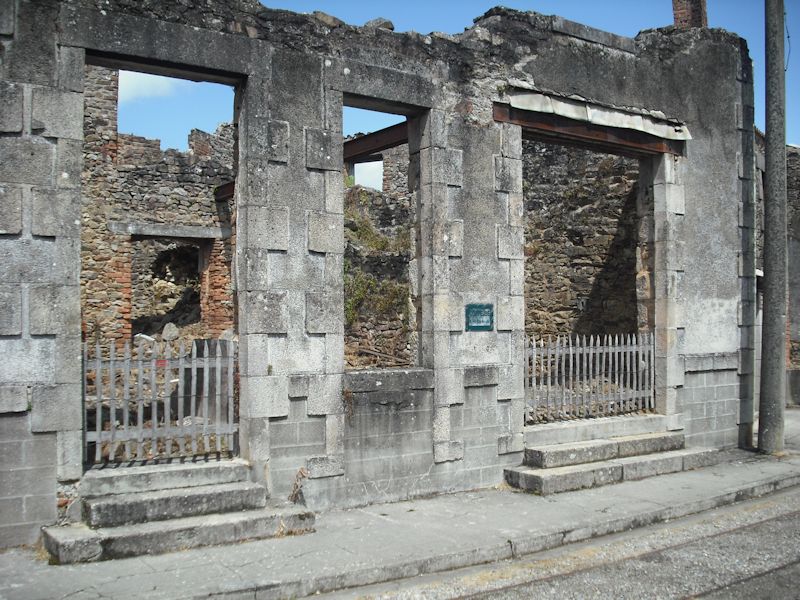
Then the Germans invited the women and children to go down the street a ways and relax in the village church. About 20 people, mostly young men fearing that this was a round-up for the "obligatory work service", hid out or bolted for the forests.
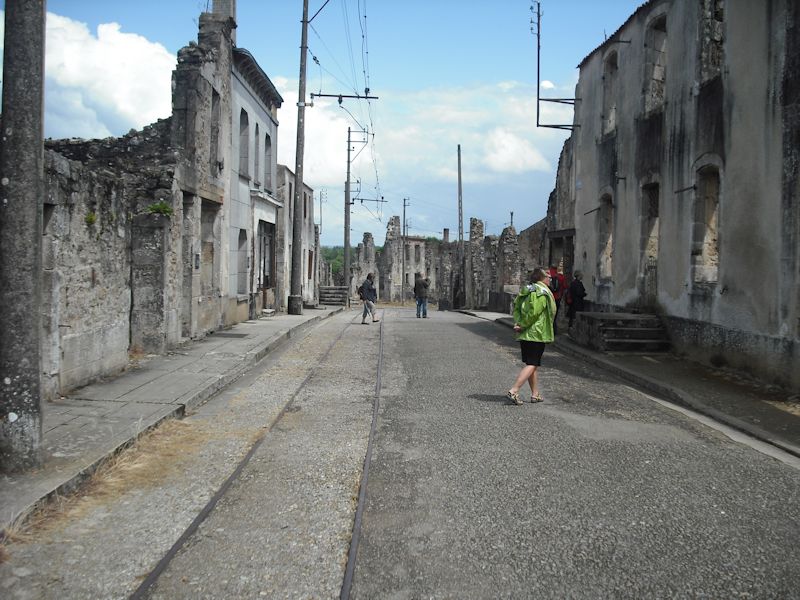
Oradour had been a fairly pretty village in its time -- that's the railroad line from Limoges coming up through the centre of town. The museum display of ruined houses identifies each of them -- the butcher, the hair-stylist (I counted five different coiffeuses), the grain merchant, the grocery, another butcher, the patisserie, the garagist, and so on -- an incredibly effective means of bringing the old village to life, not only the names and professions of the people, but the way village life must have moved about the streets in better times, who was part of whose family, and so on. A brilliant display of the museum art and science.
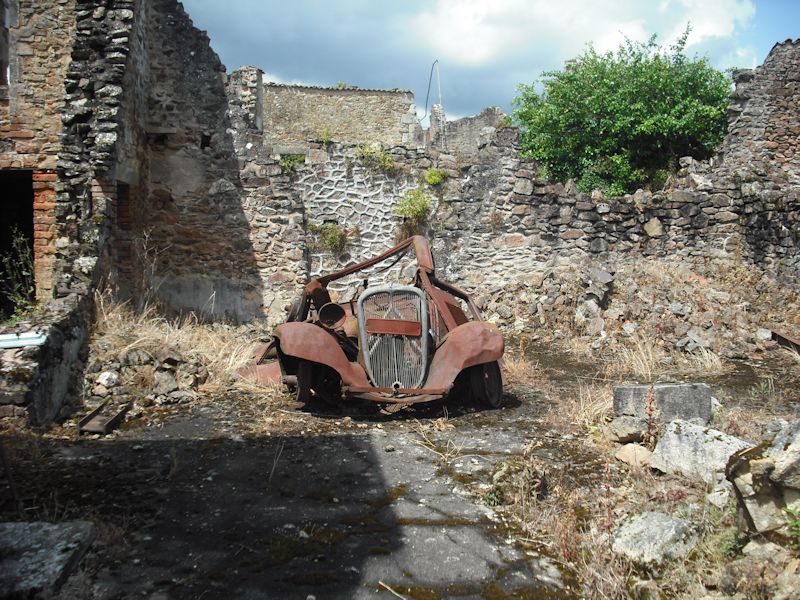
Apparently the village males noticed the German lads setting up machine-guns facing the square, but were told that that was just a normal crowd control precaution, like police in the USA brandishing tasers and shouting in a rage. By all accounts, the Germans were polite and accommodating, though, as long as everyone followed orders.
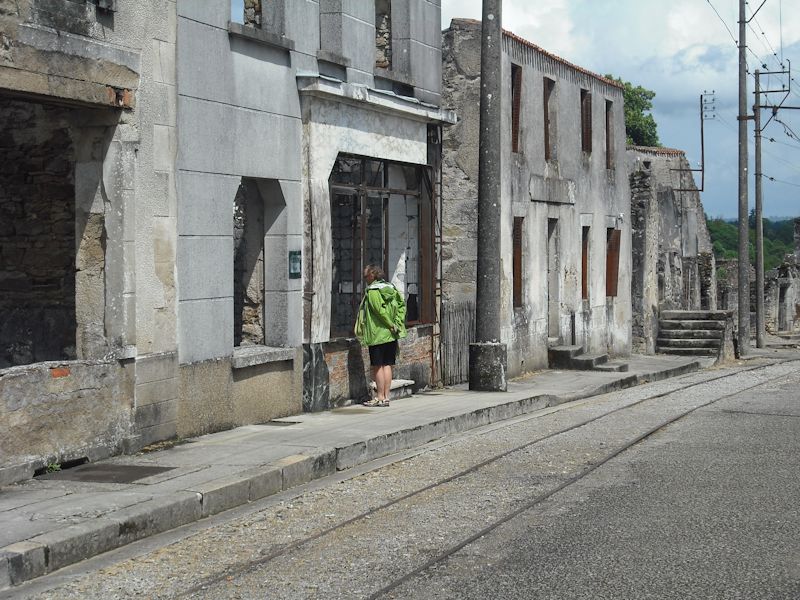
Window-shopping in Oradour, way too late.
The men were then told that there would be a search for weapons stashes and were moved to separate locations around town. Then the young SS-lads opened up with the machine guns and killed nearly all the village men and as many as had been rounded up from the nearby countryside.

Presumably it's time to ask why I always look on the bright side and face the future with a fixed smile.
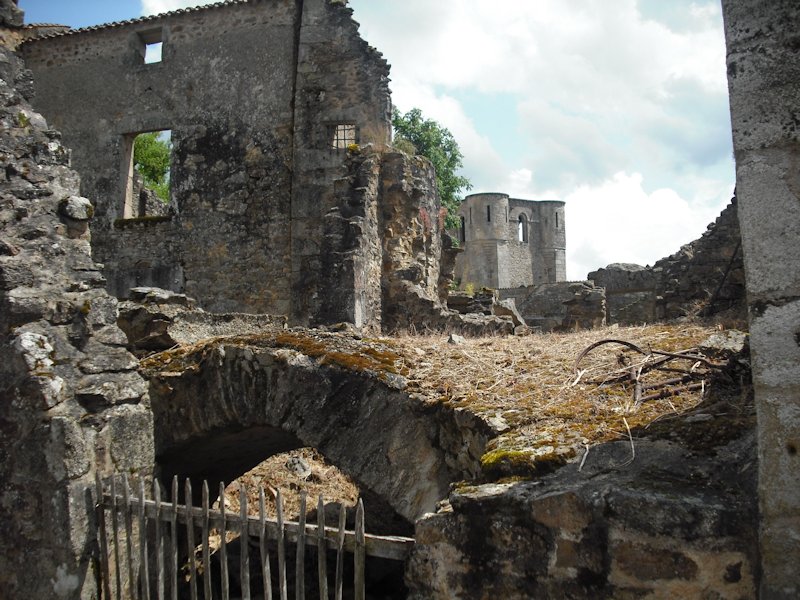
A pretty thorough germanic going-over this poor little town got. In the famous Laudy barn, where many of the men had been stashed, when the machine-guns stopped the Germans strolled about finishing off anybody still resisting the programme.

The Germans then strew straw and petrol everywhere and set everything alight. They may then have gone off to play ping-pong, because a few of the civilians in the Laudy barn had survived the holocaust and made their way out, hiding in rabbit hutches, afterwards, to tell the tale.
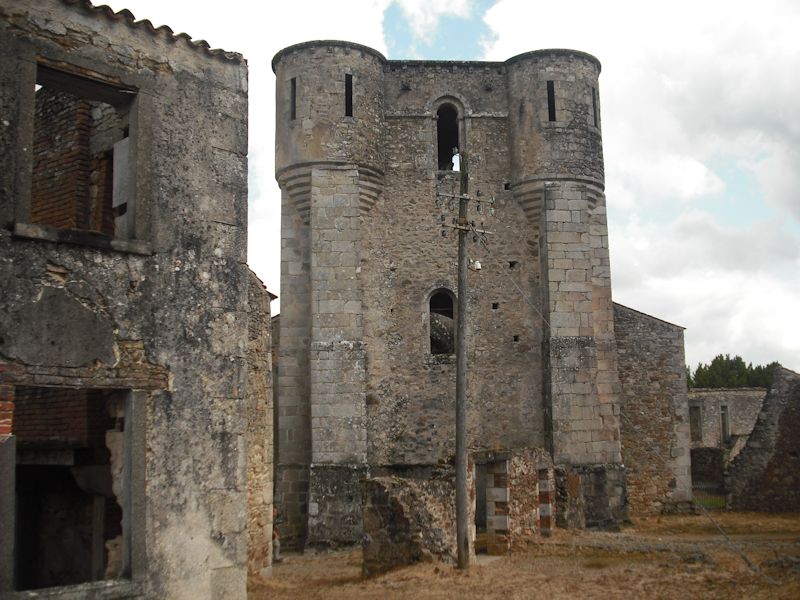
But what to do about the women and children huddled in the church, hearing gunfire outside? Grenades and smoke bombs, evidently.
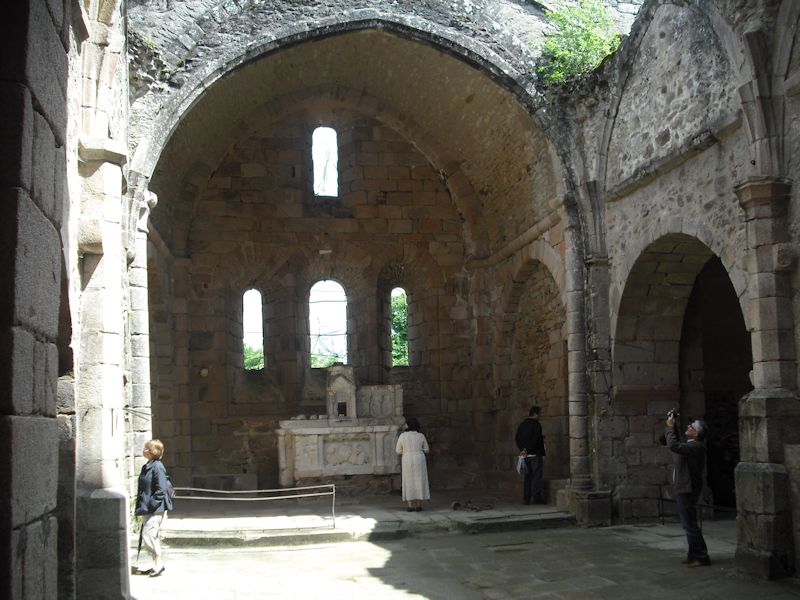
One of the surviving women, in the clouds of smoke, got out that central window behind the altar and dropped ten feet to the ground. Another woman and her baby followed her out, but a dutiful soldier, probably recently a football champion in his high school in the Alsace, shot them all and wandered off, leaving the surviving lady to feign deadness by increments on her way to the nearby woods.
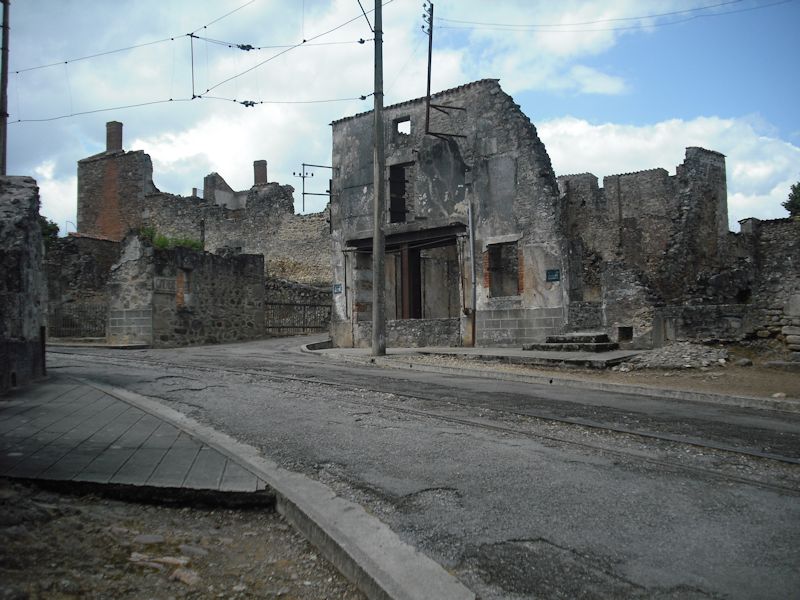
Not much left standing. In all, evidently 642 unarmed men, women, and children were murdered, and only a few got out of it. It appears to have been just another mindlessly stupid affair, and to this day there seems to be no consensus about what the purpose of it was. The village was trashed utterly, as a burnt-out kind of cover-up, but journalists arriving by train in the succeeding days have left some horrible accounts of what they saw there.
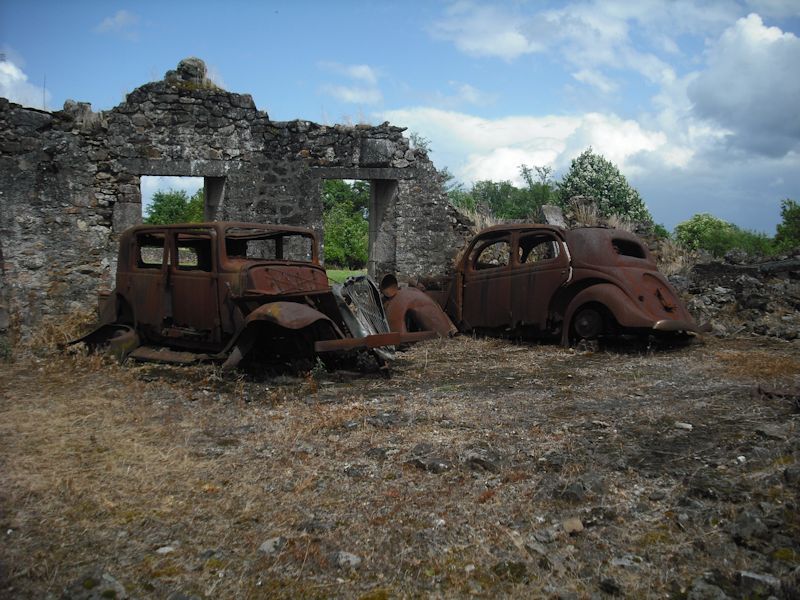
Adolf Diekmann, the commander of this mess, had created a public relations disaster, and Rommel himself offered to preside over his court martial. An SS unit came back to Oradour two days later and tried to bury the dead out of sight, but gave it up as hopeless, as journalists and aid workers were already cataloging the victims that could be identified.
Two weeks later, as the unit reached the Normandy front, moving only by night because of Allied aircraft, Diekmann was wandering around at night without his helmet and got killed by shrapnel. A few weeks after that, Rommel was implicated in the Hitler assassination plot and committed suicide. No winners anywhere.
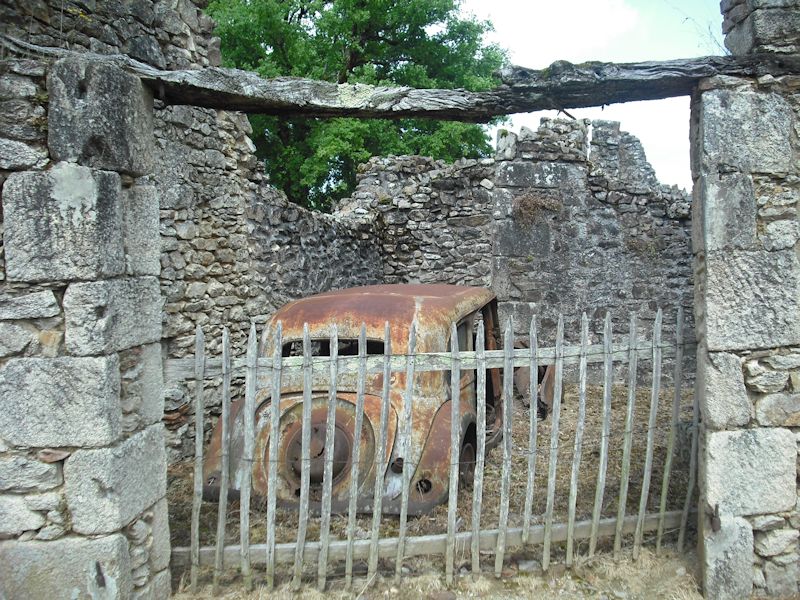
My own theory is that it all has to do with the "banality of evil" and the close proximity of uneducated young men to lots of big guns. Ominously enough, we've now in 2009 got many, many more uneducated young men slouching around without jobs but with big sacrosanct second-amendments guns, and, obviously, even more banality of evil than ever before, at least since the heydey of the Mongols.

But "Never Again". To keep the memory alive, the Oradour management seem to have dreams of becoming a world centre of "Never Again" -- here's a new exhibit under construction, probably extremely well-financed by somebody, about the 9/11 attack in the USA. As if 19 Islamic dumbshits gaming a lazy imperial homeland were anything like the systematic horrors of the 1940s.
If you haven't got beaches or scenic mountains, you need to find something to bring the tourists in. It's called "the banality of evil."
Montbrun Castle

But on a lighter note, here's the Château de Montbrun, on the back roads from Oradour in the countryside west of Chalus, south of Limoges. It's no Oradour but it's had its own somewhat chequered past. The early square keep sticking out the top of late medieval round towers creates a memorable effect on the impressionable castle fan, like me.
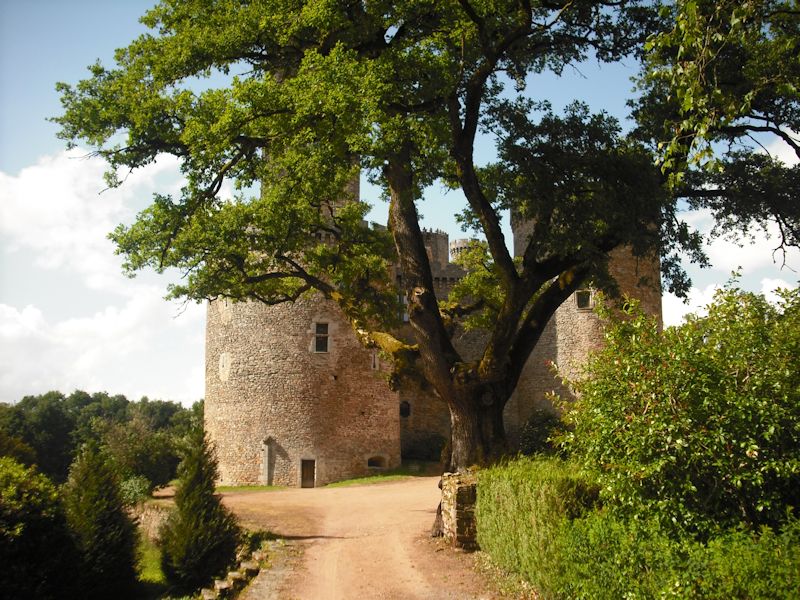
First set up in 1179 by a Crusader named Aimery Brun (the family renamed themselves Montbrun in 1366; something like Archibald Leach and Cary Grant, perhaps), the place went back and forth between the English and the French during the Hundred Years' War.

The original square corner towers were replaced by round ones after an English thrashing in the 1430s. The Protestants burnt the place out in 1562 during the Wars of Religion, and "The People" did terrible things to it during the French Revolution. Restorations got underway in 1871 and got really serious in the 1960s.
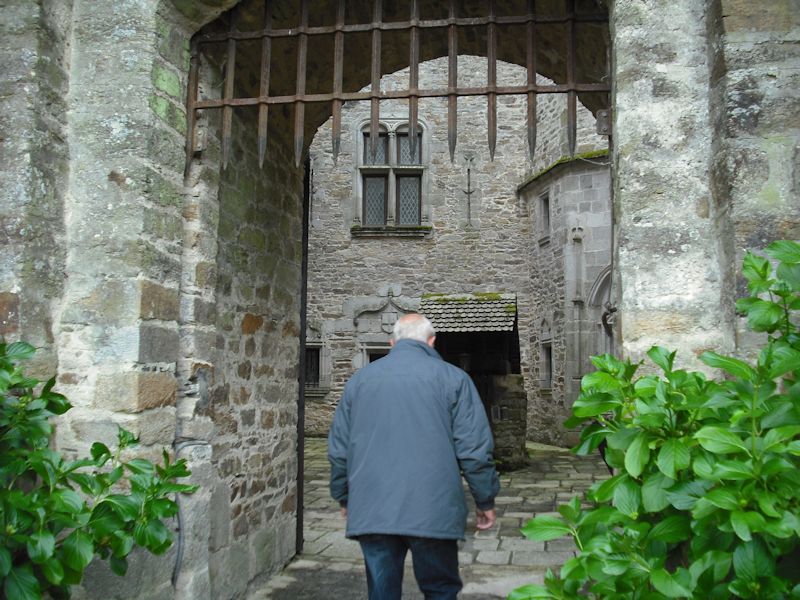
Our guide, an English gentleman with a mischievous sense of a good story.
Richard the Lionheart -- the wayward English king, rapacious Crusader, self-pitying sonneteer/prisoner in Austria, and routine pillager of his homeland, here in Aquitaine -- besieged the negligible castle of Chalus-Chabrol in March 1199, allegedly because he'd heard that a peasant had dug up a buried trove of Roman gold. He took a chance hit in the shoulder from a kid with a crossbow and became gangrenous (physically as well as morally), and one of his loyal sub-thugs, the then-current Montbrun, brought him here to the château, some 15km west of Chalus, to recover, which he didn't.
[Reality Check, 2022: According to John Gillingham's classic 1978 biography of Richard, that whole legend of his death at Chalus is bollocks, the image of Richard presented here is grossly unfair, and there's no mention there of this castle Montbrun. I think that the smart money is on Gillingham's version.]
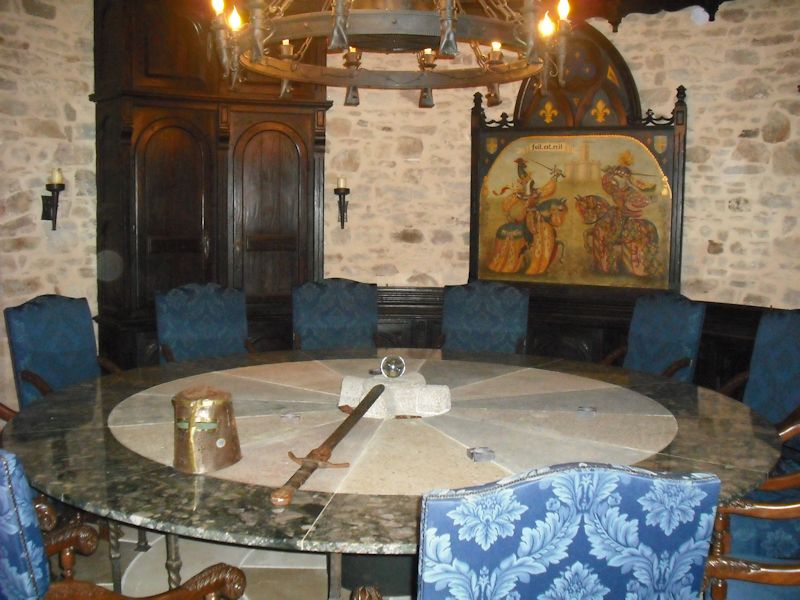
A fascinating story, if true. But it gets better! The château is now owned by a worthy Dutch gentleman who rents rooms out for high-end corporate conferences with luxurious accommodations in the towers (recessed audio-visual facilities, recessed mini-bar), and here we have, our guide tells us, King Richard's original Roundtable, where his knights could seat themselves equally with no order of precedence from the high table to the lower end.
Somewhere in this amusing spiel, I got lost between King Richard the Lionhearted and King Arthur with his legendary knights and fell to fretting about why Richard, mortally wounded and stinky with gangrene, removed in his last few days to a nearby castle, would have insisted upon bringing his original Roundtable with him. (I recall a merry guide in Cardiff Castle in Wales, in 1987, solemnly showing us tourists the room where Mary Queen of Scots spent her last night before her execution. That was a big hit with our tour group, and the guide gave me a supplicatory wink when he heard me starting to snort and spit up my Pepsi.)
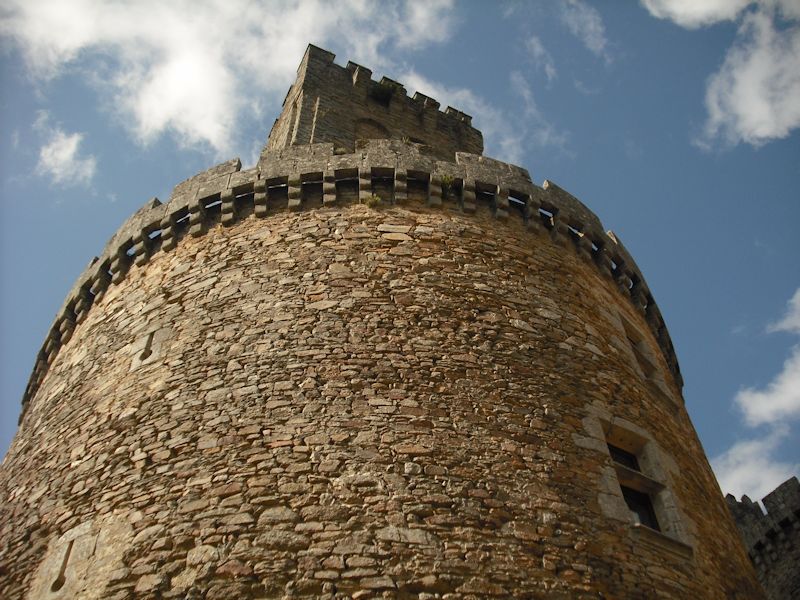
Silly as it all may sound, this square keep (which we could not visit) sprouting out of the round tower was a sight I would not have missed for anything. Nearly anything.
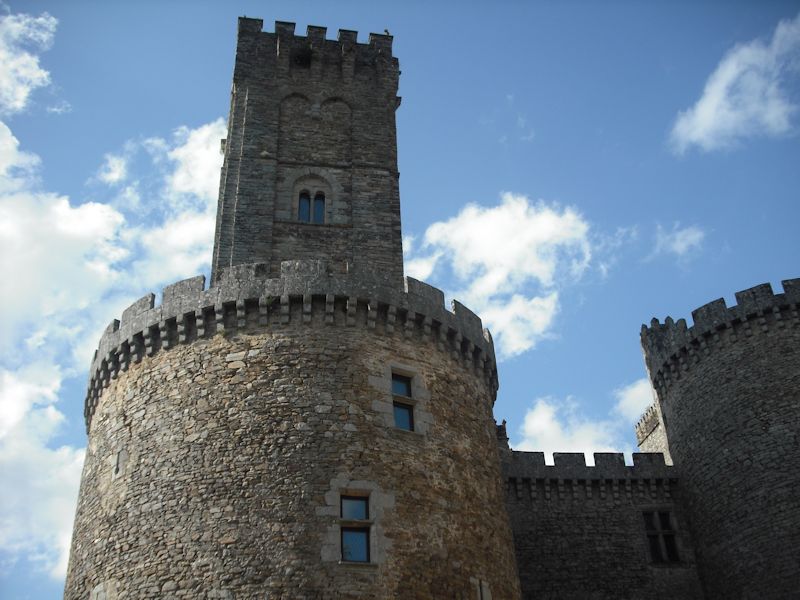
That is one goofy-looking castle keep!
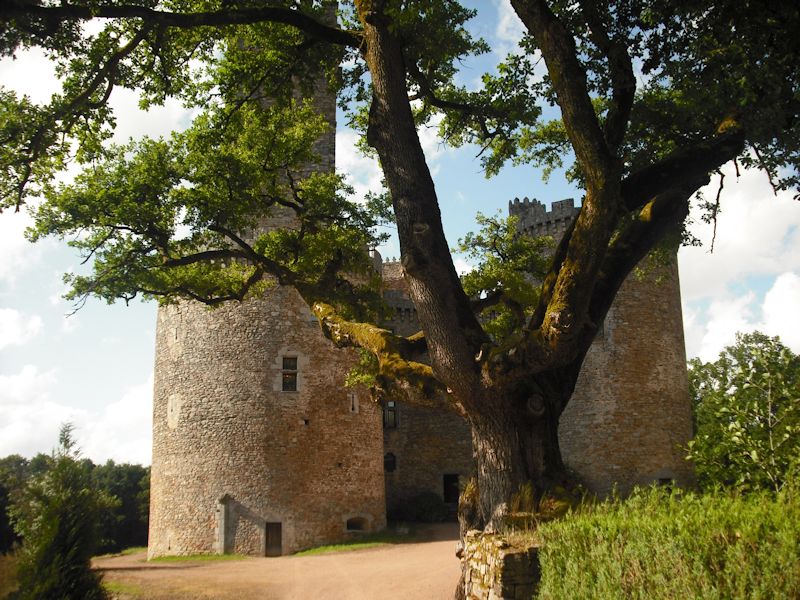
And as we head on home to Bourdeilles, our genial and inventive guide goes back across the street to La Taverne, a beautiful medieval inn just across the road now serving as a . . . tavern. To await another eager tourist.
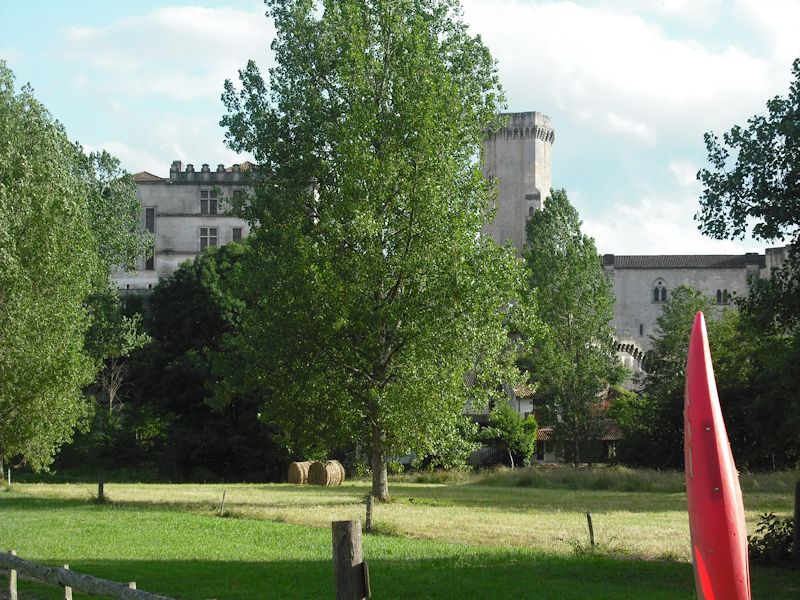
We're returning into Bourdeilles now by the back road, and that's the château just across the river Dronne. And that red thing is a kayak stood up on its end. I don't know why. We're trying to crystallize our dinner plans at this point, and all the options seem very good.
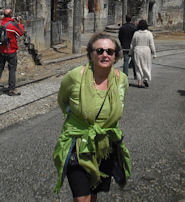 Dwight Peck's personal website
Dwight Peck's personal website






























